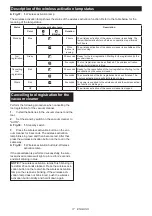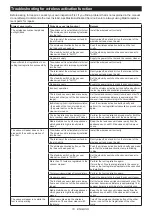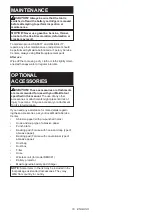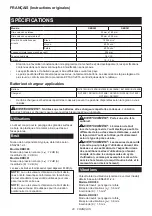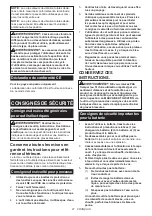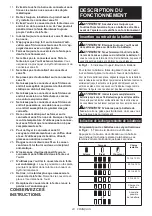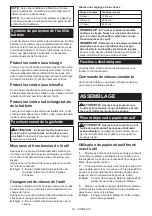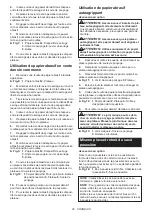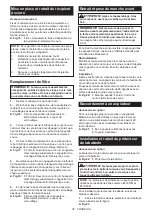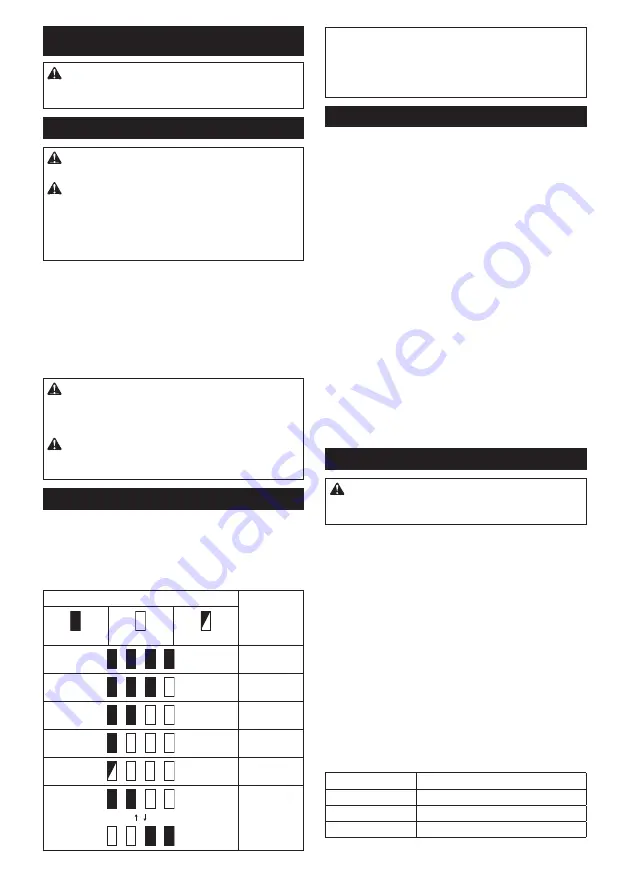
12 ENGLISH
FUNCTIONAL DESCRIPTION
CAUTION:
Always be sure that the tool is
switched off and the battery cartridge is removed
before adjusting or checking function on the tool.
Installing or removing battery cartridge
CAUTION:
Always switch off the tool before
installing or removing of the battery cartridge.
CAUTION:
Hold the tool and the battery car
-
tridge firmly when installing or removing battery
cartridge.
Failure to hold the tool and the battery
cartridge firmly may cause them to slip off your hands
and result in damage to the tool and battery cartridge
and a personal injury.
►
Fig.1:
1.
Red indicator
2.
Button
3.
Battery cartridge
To remove the battery cartridge, slide it from the tool
while sliding the button on the front of the cartridge.
To install the battery cartridge, align the tongue on the
battery cartridge with the groove in the housing and slip
it into place. Insert it all the way until it locks in place
with a little click. If you can see the red indicator as
shown in the figure, it is not locked completely.
CAUTION:
Always install the battery cartridge
fully until the red indicator cannot be seen.
If not,
it may accidentally fall out of the tool, causing injury to
you or someone around you.
CAUTION:
Do not install the battery cartridge
forcibly.
If the cartridge does not slide in easily, it is
not being inserted correctly.
Indicating the remaining battery capacity
Only for battery cartridges with the indicator
►
Fig.2:
1.
Indicator lamps
2.
Check button
Press the check button on the battery cartridge to indi
-
cate the remaining battery capacity. The indicator lamps
light up for a few seconds.
Indicator lamps
Remaining
capacity
Lighted
Off
Blinking
75% to 100%
50% to 75%
25% to 50%
0% to 25%
Charge the
battery.
The battery
may have
malfunctioned.
NOTE:
Depending on the conditions of use and the
ambient temperature, the indication may differ slightly
from the actual capacity.
NOTE:
The first (far left) indicator lamp will blink when
the battery protection system works.
Tool / battery protection system
The tool is equipped with a tool/battery protection sys
-
tem. This system automatically cuts off power to the
motor to extend tool and battery life. The tool will auto
-
matically stop during operation if the tool or battery is
placed under one of the following conditions:
Overload protection
When the tool or battery is operated in a manner that
causes it to draw an abnormally high current, the tool
automatically stops without any indication. In this sit
-
uation, turn the tool off and stop the application that
caused the tool to become overloaded. Then turn the
tool on to restart.
Overheat protection
When the tool or battery is overheated, the tool stops
automatically. In this case, let the tool and battery cool
before turning the tool on again.
Overdischarge protection
When the battery capacity is not enough, the tool stops
automatically. In this case, remove the battery from the
tool and charge the battery.
Switch action
CAUTION:
Avoid turning the tool on while it
is placed on the workpiece or on your workbench.
It may cause personal injury or damage.
Turning the tool on and off
Press the power/speed select button on the top of the
main handle to start the tool. The tool starts to run at its
highest orbital speed.
Press the stop button to pause or cease operation.
►
Fig.3:
1.
Power/speed select button
2.
Stop button
3.
Main handle
Changing the tool speed
The orbital speed can be changed in three modes, that
is, high, medium and low depending on the application
and workload.
Press the power/speed select button to switch speed
mode.
►
Fig.4:
1.
Power/speed select button
Speed settings table
Speed level
Orbital per minute
3 (High)
12,000 min
-1
(/min)
2 (Medium)
8,000 min
-1
(/min)
1 (Low)
4,000 min
-1
(/min)
Summary of Contents for DBO380
Page 2: ...2 1 2 3 Fig 1 1 2 Fig 2 1 2 3 Fig 3 1 Fig 4 1 2 3 5 4 1 4 5 2 3 Fig 5 1 2 3 Fig 6 ...
Page 5: ...5 1 2 3 3 Fig 19 1 2 3 4 Fig 20 1 2 3 4 Fig 21 1 Fig 22 Fig 23 2 1 Fig 24 ...
Page 6: ...6 Fig 25 Fig 26 Fig 27 Fig 28 1 Fig 29 1 2 3 4 Fig 30 ...
Page 7: ...7 1 2 3 Fig 31 1 Fig 32 1 2 1 2 Fig 33 Fig 34 1 Fig 35 ...
Page 8: ...8 1 2 Fig 36 1 Fig 37 1 Fig 38 1 2 1 2 Fig 39 ...
Page 127: ...127 ...

















